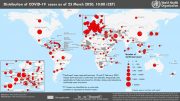
Stressful jobs with perceived low rewards can double men’s heart disease risk, as per an 18-year study on white-collar workers. The findings underscore the need for healthier work environments.
Job strain and high efforts with low reward are psychosocial stressors that are each associated with heart disease risk and the combination was especially dangerous to men, according to a new scientific study.
- Men exposed to stressful working conditions who also felt that they put forth high effort but received low rewards had twice the risk of heart disease compared to men who were free of those psychosocial stressors.
- The impact of job strain and effort-reward imbalance combined was similar to the magnitude of the impact of obesity on the risk of coronary heart disease, in the study of nearly 6,500 white-collar workers in Canada.
- Results on how work stress affects women’s heart health were inconclusive.
Men who say they have stressful jobs and also feel they exert high efforts for low reward had double the risk of heart disease compared to men free of those stressors, according to new research published on September 19 in Circulation: Cardiovascular Quality and Outcomes, a peer-reviewed American Heart Association journal.
“Considering the significant amount of time people spend at work, understanding the relationship between work stressors and cardiovascular health is crucial for public health and workforce well-being,” said lead study author Mathilde Lavigne-Robichaud, R.D., M.S., doctoral candidate, Population Health and Optimal Health Practices Research Unit, CHU de Quebec-University Laval Research Center in Quebec, Canada. “Our study highlights the pressing need to proactively address stressful working conditions, to create healthier work environments that benefit employees and employers.”
Heart Disease: A Leading Concern
Heart disease holds the dubious distinction of being the top cause of death in the U.S. according to American Heart Association statistics. In 2020 alone, nearly 383,000 Americans died of heart disease.
Research has shown that two psychosocial stressors — job strain and effort-reward imbalance at work — may increase heart disease risk. However, few studies have examined the combined effect.
“Job strain refers to work environments where employees face a combination of high job demands and low control over their work. High demands can include a heavy workload, tight deadlines and numerous responsibilities, while low control means the employee has little say in decision-making and how they perform their tasks,” Lavigne-Robichaud explained.
“Effort-reward imbalance occurs when employees invest high effort into their work, but they perceive the rewards they receive in return — such as salary, recognition or job security — as insufficient or unequal to the effort. For instance, if you’re always going above and beyond, but you feel like you’re not getting the credit or rewards you deserve, that’s called effort-reward imbalance.”
Key Study Findings
The study reveals:
- Men who said they experienced either job strain or effort-reward imbalance had a 49% increase in risk of heart disease compared to men who didn’t report those stressors.
- Men reporting both job strain and effort-reward imbalance were at twice the risk of heart disease compared with men who did not say they were experiencing the combined stressors.
- The impact of psychosocial stress at work on women’s heart health was inconclusive.
- In men, the impact of job strain and effort-reward imbalance combined was similar to the magnitude of the impact of obesity on the risk of coronary heart disease.
“Our results suggest that interventions aimed at reducing stressors from the work environment could be particularly effective for men and could also have positive implications for women, as these stress factors are associated with other prevalent health issues such as depression,” Lavigne-Robichaud said. “The study’s inability to establish a direct link between psychosocial job stressors and coronary heart disease in women signals the need for further investigation into the complex interplay of various stressors and women’s heart health.”
Potential Interventions and Broader Implications
Interventions might include different approaches, such as providing support resources, promoting work-life balance, enhancing communication, and empowering employees to have more control over their work, she said.
“The U.S. workforce is among the most stressed in the world, and these workplace stressors can be as harmful to health as obesity and secondhand smoke,” Eduardo J. Sanchez, M.D., M.P.H., FAHA, FAAFP, chief medical officer for prevention at the American Heart Association. “This study adds to the growing body of evidence that the workplace should be prioritized as a vehicle for advancing cardiovascular health for all. The American Heart Association remains committed to and engaged in providing employers with the resources and information they need to actively support the health of their employees and communities through science-backed changes to policy and culture.”
Study Specifics
Study background and details:
- Researchers studied nearly 6,500 white-collar workers, average age about 45 years old, without heart disease, and followed them for 18 years, from 2000 to 2018.
- They studied health and workplace survey information for 3,118 men and 3,347 women in a wide range of jobs in Quebec. The surveys included employees working in senior management, professional, technical, and office worker roles. Education levels ranged from no high school diploma to a university degree.
- Researchers measured job strain and effort-reward imbalance with results from proven questionnaires and retrieved heart disease information using established health databases.
One study limitation is that the researchers studied men and women in white-collar jobs primarily in Quebec, Canada, and the results might not fully represent the diversity of the American working population. However, the study findings may be relevant to white-collar workers in the United States and other high-income countries with similar job structures, according to Lavigne-Robichaud.
Reference: “Psychosocial Stressors at Work and Coronary Heart Disease Risk in Men and Women: 18-Year Prospective Cohort Study of Combined Exposures” by Mathilde Lavigne-Robichaud, Xavier Trudel, Denis Talbot, Alain Milot, Mahée Gilbert-Ouimet, Michel Vézina, Danielle Laurin, Clermont E. Dionne, Neil Pearce, Gilles R. Dagenais and Chantal Brisson, 19 September 2023, Circulation: Cardiovascular Quality and Outcomes.
DOI: 10.1161/CIRCOUTCOMES.122.009700









Of course, the whole study hinges on the self reporting of the participants, if the words of a number of those participants were rearranged, they could also describe a psychopath, or any of a number of mental afflictions; often these individuals will resort to crime in order to fulfill the reward portion of the equation; it would be interesting to go back through the data to see how many of them were either charged with a crime or convicted of one. Even here, where I live, white collar criminals hire blue collar criminals to commit homicide to supplement their income. Just saying because at least here in America it appears to be a very common practice.
Femsplain much?